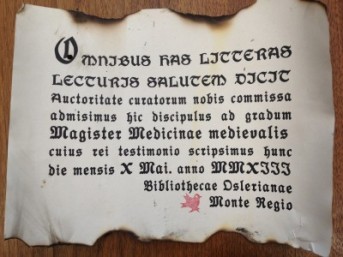 This winter at the Osler Library of the History of Medicine saw two firsts: our first high school level class visit to the library and our participation in McGill University’s first Bring a Child to Work Day. Both events highlighted ideas and questions that have been under discussion in the rare books world in recent years: What do rare book libraries have to offer younger users? Is there a place for children? And what are we doing to welcome them and make accessible our pieces of history ?
This winter at the Osler Library of the History of Medicine saw two firsts: our first high school level class visit to the library and our participation in McGill University’s first Bring a Child to Work Day. Both events highlighted ideas and questions that have been under discussion in the rare books world in recent years: What do rare book libraries have to offer younger users? Is there a place for children? And what are we doing to welcome them and make accessible our pieces of history ?
In January, forty students in the grade 11 History class at Montreal’s Beth Rivkah Academy came to the Osler Library to see a selection of medieval and early modern books. Their visit was full of enthusiasm, thoughtful questions, and intelligent discussion. Their teacher noted that the visit was successful in helping the students make real meaning out of the historical concepts and abstract ideas learned in class.
McGill’s first ever Bring a Child to Work Day was another opportunity to allow children to interact with rare books. Based on Take Our Daughters to Work Day, an annual event launched in 1993 to inspire young girls to join the professional workforce, the 2013 version at McGill was open to all children and based around a number of wide-ranging activities in departments across campus. Our young visitors were excited to see historical items from an ancient Assyrian tablet to a Renaissance flap book. Not only did they see documents from the past, but with teaching materials, including a modern sheet of parchment and moveable type, they were also able to better understand the technology that enabled premodern communication. Following a visit to the Osler Room, the group participated in an activity entitled “Medieval Med School.” They learned the basic concepts of medieval medicine and, using a variety of colourful, kid-friendly reference tools, diagnosed and prescribed courses of treatment for “medieval” patients.
Rare book libraries continuously seek to engage undergraduate students through class visits and the use of digitized primary resources in the classroom, but working with high school and even younger learners is still much rarer. Yet special collections like Osler’s have enormous potential to illuminate history for younger students. Historical books and documents can be especially valuable because they show that people in earlier ages thought, researched, wrote, and communicated like us, and had cultural and scientific conversations of as much complexity as we have today.
By Anna Dysert, Osler Library of the History of Medicine












Leave a Reply
You must be logged in to post a comment.